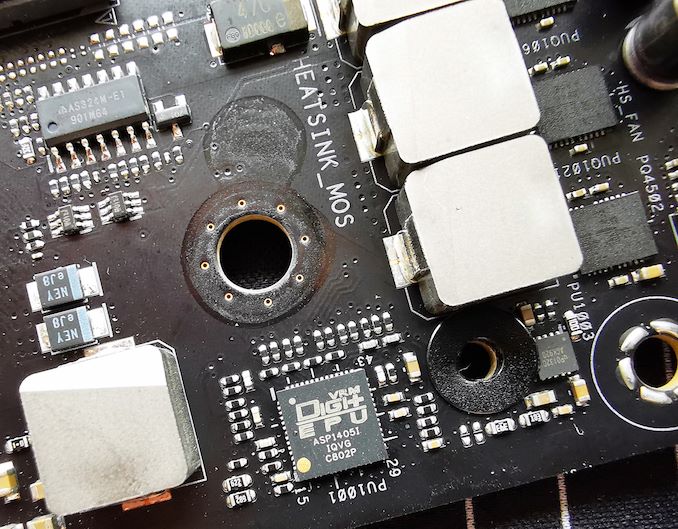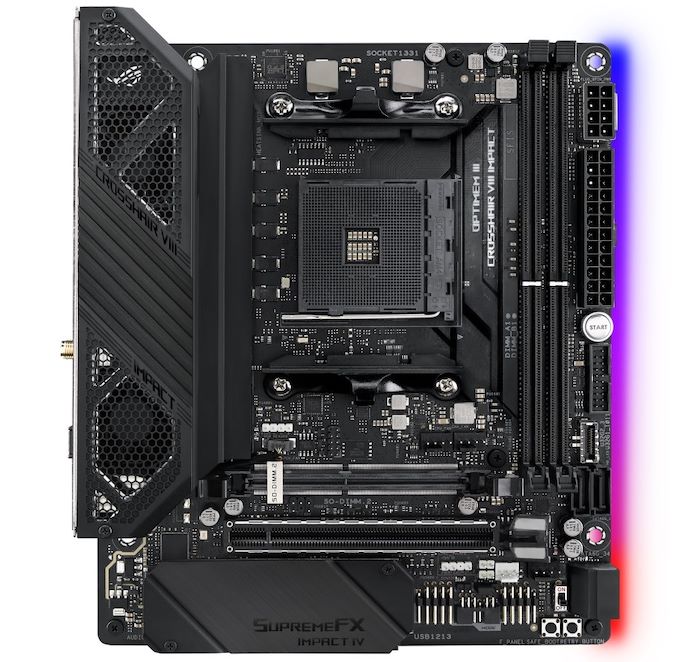The ASUS ROG Crosshair VIII Impact: A Sharp $430 Impulse on X570
by Gavin Bonshor on October 25, 2019 11:30 AM ESTDeep Impact
The ASUS ROG Crosshair VIII Impact costs $430. There's no getting away from it - this is by far the most expensive small form factor motherboard at present on the X570 chipset. There ASUS ROG Crosshair VIII Impact also throws up an interesting question for SFF systems, with its slightly larger mini-DTX form factor. The Impact is effectively in a class of its own at the price point and with the unique DTX form factor. That being said, while the primary target market of the Impact is enthusiasts looking to build a smaller form factor, the truth is that the mini-DTX size does cancel out any mini-ITX chassis designs, causing the user to look at micro-ATX cases.
Its core feature set comes also comes from its use of the SO-DIMM.2 slot which allows users to add two PCIe 4.0 x4 M.2 drives in with both NVMe and SATA support included. Outside of this is four SATA slots, with two straight-angled, and two right-angled ports with RAID 0, 1, and 10 support out of the box. The provided networking support of Intel's I211-AT Gigabit Ethernet controller raises questions as to why a model costing $430 is still reliant on a single gigabit Ethernet port, but the inclusion of an Intel AX200 Wi-Fi 6 wireless interface which adds BT 5.0 connectivity does offer some credence to the price tag.
Another interesting feature is how the SupremeFX S1220 HD audio codec and assisting ESS ES9023P DAC has been implemented to save even more space on the ROG Crosshair VIII Impact; through an M.2 B-key slot located just below the full-length PCIe 4.0 x16 slot. The S1220 HD codec itself comes with EMI shielding and plenty of gold Japanese audio capacitors, and as from most onboard audio solutions, is well isolated from the rest of the board's componentry. This is covered by a ROG themed black metal fascia which fits in with the rest of the Impact's neutrally black color scheme.
The overall design of the ROG Crosshair VIII Impact is clean, concise and for what it has in integrated RGB along the right-hand side of the board, it looks good and not overpowering. Users can expand on this with two ARGB connectors, one on the PCB itself and one on the SO-DIMM.2 add-on card. The SO-DIMM.2 also adds two 4-pin fan headers in addition to the three 4-pin headers located on the board; one for a CPU fan, one for a water pump, and another designated as a chassis fan header. This further adds to the Impact as both a premium model and one that's suitable for water cooling.
Looking at connectivity, on the rear panel is plenty of USB support which consists of five USB 3.1 G2 Type-A, one USB 3.1 G2 Type-C, and two USB 3.1 G1 Type-A ports. Unlike most conventional models, ASUS includes its LED Debugger on the rear panel and for good measure, also include a reset switch, a clear CMOS button, and a USB BIOS Flashback button. There are just three 3.5 mm audio jacks on the rear panel so users looking to use surround sound or speaker setups with more than three outputs will need to use the front panel audio header also featured on the M.2 B-key audio card; there's also a single S/PDIF optical output. The ASUS ROG Crosshair VIII Impact doesn't feature any video outputs but for a model to this standard and caliber, it would be expected that users will use a discrete graphics card.

The ASP1405I 8-phase PWM controller on the ASUS ROG Crosshair VIII Impact
The ASUS ROG Crosshair VIII Impact also performs very competitively with other X570 models on testing, with fast non-UEFI POST times, consistent power consumption and good computational performance. Couple that in with the impressive power delivery thermal performance which is underpinned by the 30 mm cooling fan directly over the heatsink is something all premium models should consider implementing. ASUS takes this further with a backplate that has a heatpipe in which is useful as the 2-phase SoC section is mounted on the rear of the board. The 8-phase CPU power delivery is teamed and performs very well in our overclocking testing with good VDroop for better efficiency, and has plenty of support for overclockers looking to take Ryzen 3000 under more extreme cooling methods such as LN2 with its own LN2 mode. At default settings, ASUS is known for its solid out of the box optimizations, but for overclocking, the Impact is the Dirty Harry of the small form factor X570 offerings.
It's hard to compare a $430 model such as the ASUS ROG Crosshair VIII Impact to other models which it dwarves in price. The next best model in terms of size is the ASRock X570 Phantom Gaming-ITX/TB3 ($240) which is mini-ITX and has Thunderbolt 3 support. While the ASUS ROG Crosshair VIII Impact is a solid board and looks to provide a very rigid platform to build on, the price really does take it out of the market for all but the extreme systems.











59 Comments
View All Comments
Holliday75 - Friday, October 25, 2019 - link
Been a bit disappointed in Zen2, X570/PCI4 boards in general and fans certainly do not help. Bleeding edge for sure, but bleeding edge issues as well. My I7-3770k (longest lasting CPU I ever had) is going to have to last another year. Hoping Zen3 things settle down and the tech is mature enough to jump on board.hansmuff - Friday, October 25, 2019 - link
On any decent board you can set a fan curve and effectively silence the fan. On my Gigabyte X570 it never runs at all even in intense benchmark or gaming sessions. I do agree that having fans back on motherboards is just crap and should have been avoided. I can only guess that there are edge cases that made AMD demand this level of cooling, I just haven't found it yet.Korguz - Friday, October 25, 2019 - link
all these people complaining about the chipset fan.. the 2 fans for my cpu cooler would probably drown it out, and is probably louder, let alone the other 6 case fans i have in my case...PeachNCream - Saturday, October 26, 2019 - link
Concerns from most people are about fan longevity and not noise, although I will readily admit that after using several low end laptops that rely purely on passive cooling and eMMC or other form of solid state storage, the silence is difficult to give up in exchange for what feels like a archaic, non-portable box filled with fans. That's really where I'm at in computing these days. My needs, even gaming, are met by passively cooled, tiny laptops and I really see no reason to go back to desktop computers, dedicated GPUs, and systems that need cooling fans.Korguz - Saturday, October 26, 2019 - link
i have fans from 5+ years ago, spinning 8-10 hrs a day, that still work just fine, i even booted up an old A64 fx60, with an Asus board, that has a chipset fan, and it still works just fine. so i dont get the longevity aspect..sorry PeachNcream, but you always comparing a desktop vs a notebook, kind of makes your view moot. a desktop will, for the most part, always be louder then a notebook, and the fact that you use passively cooled ones on top of that, further makes it moot
you needs may be met by such a laptop, but, what games do you play???????? that's the key, my guess, nothing that was released in the last few years if they run fun on such a laptop, or facebook type games. i have some old games, that i bet, would make your laptop cry, and on the one i have, to get them to play, its medium graphics or less. but each use case is different, but also, cant compare them, equally.
PeachNCream - Saturday, October 26, 2019 - link
Your older motherboard is a sample size of one.TheinsanegamerN - Sunday, October 27, 2019 - link
I have a nforce 2 motherboard running windows xp, and it has had its chipset fan replaced several times before getting a large heatsink upgrade to be rid of that annoyance.I vividly remember my pentium II/III PCs getting new fans every year, because those tiny fans would gum up and become rattly garbage.
I still replace laptop fans on the regular that are 3-4 years old and are used on a daily basis.
There is a reason so many people have an aversion to tiny fans. They are junk.
Oliseo - Sunday, October 27, 2019 - link
If you've no interest, why read the articles, let alone argue with people in the comments.AshlayW - Monday, October 28, 2019 - link
No one cares that you use a passive mobile potato for your Facebook gaming needs. This website is about hardware enthusiastsPeachNCream - Wednesday, October 30, 2019 - link
Ah, I understand now. Because I don't use a computer in the same way you do and my opinion threatens yours, it's clearly the case that we need to make up rules here at Anandtech that disallow somone from reading an article until they can prove that it is directly relevant to the computing choices they currently make.What a flawed method of arguing -- of all things, over the presence of a small cooling fan. Feel threatned about a couple of 30mm fans that might fail? Defend the lack of noise! On wait, it's isn't about noise?! You're not allowed to be here arguing in the first place with your point about fan failures!
What children you're acting like over your toys and hobbies.